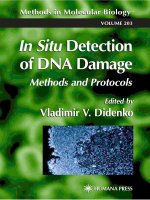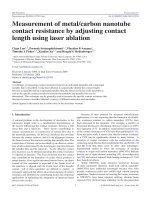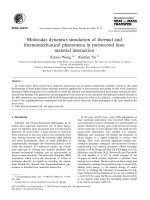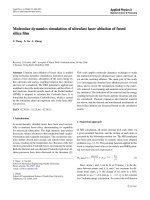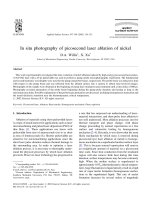in situ photography of picosecond laser ablation of nickel
Bạn đang xem bản rút gọn của tài liệu. Xem và tải ngay bản đầy đủ của tài liệu tại đây (412.98 KB, 6 trang )
In situ photography of picosecond laser ablation of nickel
D.A. Willis
1
,X.Xu
*
School of Mechanical Engineering, Purdue University, West Lafayette, IN 47907, USA
Abstract
This work experimentally investigated the time evolution of nickel ablation induced by high-energy picosecond laser pulses.
A Nd:YAG laser with a 25 ps pulsewidth was used to perform a pump–probe microphotography experiment. The fundamental
and second harmonic wavelengths were used for the pump and probe beams, respectively. The probe beam was delayed in time
with respect to the pump beam and was reflected from the ablated surface into a camera to obtain time-resolved images.
Photographs of the sample were obtained at the beginning of pump laser irradiation and continued until a time delay of 800 ps.
Photographs revealed attenuation of the probe beam beginning during the pump pulse duration and lasting as long as the
maximum time delay. Possible explanations of the probe beam attenuation are discussed, including homogeneous nucleation and
the metal–dielectric transition near the thermodynamic critical temperature.
# 2002 Elsevier Science B.V. All rights reserved.
Keywords: Picosecond laser; Ablation; Heat transfer; Homogeneous nucleation; Phase explosion
1. Introduction
Ablation of materials using short pulsewidth lasers
is a topic of much interest for applications such as laser
micromachining and pulsed laser deposition (PLD) of
thin films [1]. These applications use lasers with
pulsewidth from tens of nanoseconds (ns) to as short
as tens of femtoseconds (fs). Shorter pulsewidths are
attractive for micromachining applications since the
short laser pulse duration reduces thermal damage to
the surrounding area. In order to optimize a laser
ablation process, it is necessary to thoroughly under-
stand the physical processes by which laser ablation
proceeds. However, laser technology has progressed at
a rate that has surpassed our understanding of laser–
material interactions, and short pulse laser ablation is
not well understood. Most ablation processes involve
thermal transport and phase change, with phase
change proceeding by normal vaporization at a free
surface and volumetric boiling by homogeneous
nucleation [2–4]. Recently, it was shown that the most
likely mechanism by which mass is removed during
picosecond (ps) laser ablation of metals is homoge-
neous nucleation in a superheated molten surface layer
[5]. This is because normal vaporization will remove
an insignificant amount of material on a picosecond
time scale. Since heat conduction from the irradiated
region will also remove little heat during this time
duration, surface temperatures may become extremely
high. When the molten surface is superheated to
approximately 0.9T
cr
(thermodynamic critical tempera-
ture), large fluctuations in liquid density result in a high
rate of vapor nuclei formation (homogeneous nuclea-
tion) in the superheated liquid. This rate of nuclei
formation increases by several orders of magnitude
Applied Surface Science 197–198 (2002) 118–123
*
Corresponding author. Tel.: þ1-765-494-5639;
fax: þ1-765-494-0539.
E-mail address: (X. Xu).
1
Present address: Department of Mechanical Engineering,
Southern Methodist University, P.O. Box 750337, Dallas, TX
75275-0337, USA.
0169-4332/02/$ – see front matter # 2002 Elsevier Science B.V. All rights reserved.
PII: S 0169-4332(02)00314-8
over a very short temperature span, resulting in a rapid
liquid–vapor phase change (phase explosion) that will
eject a mixture of vapor and liquid droplets [2].There
are still questions regarding phase explosion induced by
picosecond laser pulses, since a finite amount of time is
required for the formation of an equilibrium distribu-
tion of homogeneous nuclei in the superheated melt
[4,5]. This time lag for nuclei formation has been
calculated to be on the order of 1–10 ns [6],which
makes the formation of homogeneous nuclei unlikely
during heating with laser pulses less than 1 ns. This
work addresses these issues by performing time-
resolved imaging of a metal surface during and after
pulsed laser heating in an attempt to observe the laser
ablation phenomenon.
2. Experimental apparatus and procedure
The experimental apparatus is shown in Fig. 1. The
laser source is a mode-locked Nd:YAG laser with a
pulsewidth of 25 ps (FWHM). The laser beam is split
to form two beams, the pump beam and the probe
beam. The pump beam is used for ablation of the
sample at the fundamental wavelength (1064 nm). The
probe beam is used for imaging of the sample surface
during ablation. After the pump and probe beams are
split, the probe beam is directed through a second
harmonic generator to convert a fraction of the light to
a wavelength of 532 nm. Any light remaining at the
fundamental wavelength is removed in an infrared
absorbing filter. The probe beam then travels through a
retroreflecting prism that is mounted on a micrometer
stage. Moving the position of the prism changes the
path length of the probe laser and the arrival time of
the probe beam (with respect to the pump beam) at the
sample surface. The probe beam is incident on the
sample at an angle of approximately 258. The reflected
portion of the probe beam is viewed by a microphoto-
graphy system at the same angle. Photographs are
taken with 400 speed black and white film. Separate
photographs were taken at different time delays, and
multiple sets of photos were taken at a given laser
fluence. The sample is moved after each photograph
such that each photograph is of a region that was not
previously ablated. The exact spatial irradiance dis-
tribution of the laser beam on the target was not
known, but appeared to be semi-Gaussian from the
Fig. 1. Experimental apparatus for pump–probe microphotography.
D.A. Willis, X. Xu / Applied Surface Science 197–198 (2002) 118–123 119
observed damage pattern. The spot diameter was mea-
sured from visual observation of the damaged area at
high fluence to be about 110 mm. Experiments were
performed for average incident laser fluences ranging
from 1.2 to 5.3 J/cm
2
. It was determined by previous
experiments that the threshold fluence for phase explo-
sion in nickel is 2.0 J/cm
2
[4]. Time delays ranged from
À30 ps to approximately 800 ps. A time delay of zero
represents the time at which the peak irradiance of the
pump and probe beams overlap in time. The first two
experiments were performed below the phase explosion
threshold, while in the remainder of the experiments the
fluence exceeded that required for phase explosion. In
all the experiments, the power density is not sufficient
to cause the non-linear absorption effect [7].
3. Results and discussion
Microphotographs below the phase explosion
threshold are shown in Fig. 2 for an average fluence
of 1.2 J/cm
2
. The fluence is noted below each photo-
graph. The variation in fluence is a result of pulse-to-
pulse variations in laser energy. The initial photo-
graphs at time delays from À30 to 10 ps show only
reflected probe beam light from the nickel surface,
which appears as white in the photographs. The square
region shown is approximately 145 mm  145 mm,
much larger than the pump beam diameter. The
reflected probe beam becomes attenuated in the cen-
tral region of the photographs after a time delay of
20 ps. This attenuated region increases to a diameter
of 64 mm at 100 ps, with some fluctuations in diameter
due to changes in pump beam irradiance. The level of
attenuation also increased between 20 and 100 ps.
After 100 ps the diameter does not change signifi-
cantly, although the level of attenuation appears to
decrease gradually with time, as indicated by the
increased amount of reflected light reaching the cam-
era. The final photograph at infinity was taken several
seconds after the pump pulse, and no surface damage
is visible. This is to be expected since this fluence is
below the phase explosion threshold.
It should be noted that the ablation threshold dis-
cussed here is a threshold for a significant amount of
material being removed by a laser pulse causing
visible damage to the target. Below the threshold,
experiments showed that the target surface was rough-
ened, but no net material removal resulted. If multiple
pulses were allowed to reach the surface, only further
Fig. 2. Transient microphotographs of ablation at average fluence of 1.2 J/cm
2
.
120 D.A. Willis, X. Xu / Applied Surface Science 197–198 (2002) 118–123
roughening was observed with no change in depth. It
was found through a numerical calculation that sur-
face evaporation during picosecond laser heating does
not cause a significant amount of material removal
(less than 1 A
˚
) [5]. In other words, surface evaporation
may still occur at the laser fluence used in this
experiment (1.2 J/cm
2
). The rings around the laser
irradiated spot shown at 220–600 ps could be due to
the gas dynamic effect from evaporation, though they
can also be caused by sudden heating and expansion of
the air adjacent to the heated surface.
The remainder of the photographs are for experi-
ments above the phase explosion threshold fluence of
2.0 J/cm
2
. Results of ablation at an average fluence of
2.3 J/cm
2
are displayed in Fig. 3. Probe beam attenua-
tion began as early as 0 ps, with the diameter of the
attenuated region increasing to approximately 81 mm
at 50 ps. A distinct, sharp boundary to this region is
visible after 140 ps. The level of attenuation again
decreases very gradually with time, and at a time
delay of 800 ps the entire ablated region has a reflec-
tivity similar to that of the non-ablated region. This
region also has a sharp boundary that coincides with
the damaged region shown in the final photograph
at infinity. Photographs at an average fluence of
3.1 J/cm
2
are shown in Fig. 4. Probe beam attenuation
begins at À10 ps and expansion of the attenuated
region continues until approximately 70 ps. The sharp
boundary to the ablated region appears at approxi-
mately 100 ps, with a diameter of 93 mm. Reduction in
probe beam attenuation is noticed after 300 ps. The
final photograph at infinity has a diameter of approxi-
mately 93 mm, which is the same as the photograph at
800 ps. Similar results are seen in the photographs of
Fig. 5 at an average fluence of 5.3 J/cm
2
. At this
fluence probe beam attenuation beginning at À30 ps
and the attenuated region is fully expanded to a
diameter of approximately 104 mm at 50 ps. Strong
attenuation exists until 700 ps, although there is slight
reduction in attenuation at the outer edges of the
ablated region. The final photograph at infinity shows
a damaged region of the same diameter as the atte-
nuated region in the transient photographs.
The cause of the probe beam attenuation (darkening
of the image) in the photographs needs to be discussed.
The attenuation is present for laser fluences above and
below the phase explosion threshold. Since it is present
in the photographs below the threshold, it is not exp-
ected to be caused by a mass removal process at low
laser fluences. The possible causes of the attenuation
Fig. 3. Transient microphotographs of ablation at average fluence of 2.3 J/cm
2
.
D.A. Willis, X. Xu / Applied Surface Science 197–198 (2002) 118–123 121
Fig. 4. Transient microphotographs of ablation at average fluence of 3.1 J/cm
2
.
Fig. 5. Transient microphotographs of ablation at average fluence of 5.3 J/cm
2
.
122 D.A. Willis, X. Xu / Applied Surface Science 197–198 (2002) 118–123
should indicate that the attenuation in all of the photos is
a result of absorption or scattering processes that appear
the same when imaged by the reflected probe beam. A
very likely mechanism is the metal-to-dielectric transi-
tion when the surface temperature approaches the ther-
modynamic critical point. If the laser fluence, although
below the threshold for phase explosion, is high enough
for the surface to reach 0.8T
cr
, then large density
fluctuations in the superheated liquid will result in a
transition from a metal to a dielectric [2]. This transition
to a dielectric material will result in increased transpar-
ency and scattering of the probe beam. It is expected that
the reflectivity will be that of other dielectric materials,
on the order of 10%. However, the target surface layer
will no longer be a homogeneous media, as there will be
many scattering centers, making the index of refraction
and optical properties difficult to calculate and the
reflectivity and transmissivity difficult to estimate. In
addition to the scattering at 0.8T
cr
, if the laser fluence is
high enough for the surface to reach 0.9T
cr
, then homo-
geneous nucleation will result in phase explosion,
resulting in the ejection droplets of superheated liquid.
Both of these processes will result in scattering and
attenuation of the probe beam. On the other hand, the
probing beam attenuation is seen as late as 800 ps at
higher laser fluences, when the ablation process should
have ended but the surface can still maintain a very high
temperature. Therefore, the attenuation of the probing
beam at this time indicates that the cause of attenuation
is very likely to be the metal-to-dielectric transition.
4. Conclusions
This work presents time-resolved images of pico-
second laser ablation of a metal, with picosecond time
resolution. It was shown that attenuation of the
reflected probe beam begins within the laser pulse
duration and lasts for more than 800 ps. Possible
causes of the change in surface reflectivity are scatter-
ing by fluctuations in the superheated liquid near
0.8T
cr
and possibly also by scattering by ejected
droplets near 0.9T
cr
. The high temperature state that
sustains the metal-to-dielectric transition could last for
hundreds of picoseconds after the laser pulse. Further
studies are needed to distinguish between the metal–
dielectric transition and phase explosion, so that to
reveal the details of the laser ablation process.
Acknowledgements
The authors gratefully acknowledge support for this
work from the National Science Foundation and the
Office of Naval Research. Experimental work was
performed in the Facility for Laser Spectroscopy
and Photochemistry, Department of Chemistry, Pur-
due University. D.A. Willis would like to thank Dr.
Hartmut Hedderich, Director of the Facility for Laser
Spectroscopy and Photochemistry, for his assistance
and useful technical discussions.
References
[1] S.M. Metev, V.P. Veiko, Laser-assisted Microtechnology, 2nd
Edition, Springer, Berlin, 1998.
[2] A. Miotello, R. Kelly, Appl. Phys. Lett. 67 (1995) 3535.
[3] A. Miotello, R. Kelly, Appl. Phys. A 69 (1999) S67.
[4] X. Xu, D.A. Willis, J. Heat Transfer. 124 (2002) 293.
[5] D.A. Willis, X. Xu, Int. J. Heat Mass Transfer, accepted.
[6] M.M. Martynyuk, Sov. Phys. Tech. Phys. 19 (1974) 793.
[7] M.M. Murnane, R.W. Falcone, Proc. SPIE 913 (1988) 5.
D.A. Willis, X. Xu / Applied Surface Science 197–198 (2002) 118–123 123

